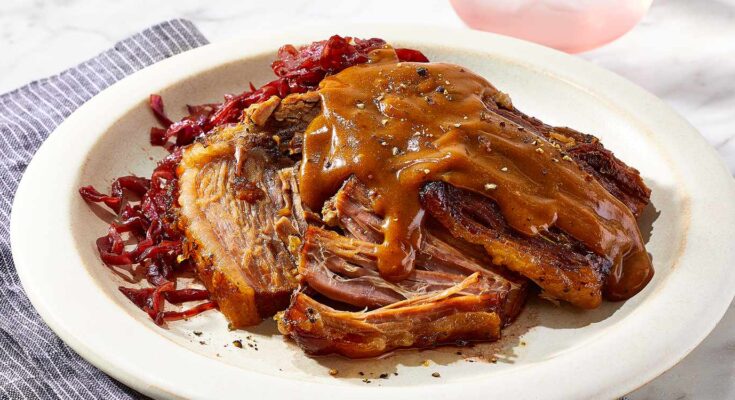German Sauerbraten Recipe: Sauerbraten. Even the name has a rich, rustic ring to it. This iconic German dish is the kind of hearty, flavorful comfort food that warms you from the inside out. Think of it as Germany’s answer to pot roast—but with a deliciously tangy twist. Sauerbraten literally translates to “sour roast,” and that name comes from its unique preparation method. What sets it apart? The meat is marinated for several days in a mixture of vinegar, wine, spices, and vegetables, which breaks down the fibers, tenderizes the meat, and infuses it with mouthwatering flavor.
This dish has been a staple in German kitchens for centuries, and while it takes a little planning ahead, every bite is worth it. Traditionally made with beef, Sauerbraten can also be made with pork, venison, or lamb, depending on the region and preference. But beef is the most classic and popular version you’ll find.
Why Sauerbraten is a Must-Try German Dish
If you love deep, rich flavors with just the right amount of tang, Sauerbraten belongs at the top of your culinary bucket list. This dish is more than just a roast—it’s a testament to German home-cooking tradition. Sauerbraten is often served during holidays, family get-togethers, and special Sunday dinners. It’s one of those meals that brings everyone to the table.
One of the most compelling things about Sauerbraten is its complexity. The marinade does a lot of the heavy lifting here, combining vinegar’s acidity with the earthy notes of bay leaves, juniper berries, cloves, and peppercorns. This combination gives Sauerbraten its unmistakable aroma and taste. After marinating for days, the meat is slow-braised until fork-tender and finished with a silky, slightly sweet gravy that often includes gingersnaps for texture and balance.
Types of Sauerbraten Across Germany
Sauerbraten varies depending on where you are in Germany, and each regional twist adds a special flair to the dish:
- Rhineland Sauerbraten: This version is probably the most famous. It’s known for its sweet-sour flavor thanks to the addition of raisins or sugar and gingersnaps in the sauce.
- Franconian Sauerbraten: Found in northern Bavaria, it’s more savory than sweet and often uses wine in the marinade.
- Saxon Sauerbraten: This East German style features a tangier flavor profile, usually with less sweetness and a more intense vinegar-forward taste.
No matter which version you choose to cook, you’re in for a rich experience that will transport you straight to a cozy German inn.
List of Ingredients You’ll Need
Here’s everything you’ll need to create an authentic German Sauerbraten:
Meat:
- 3 to 4 lbs beef roast (preferably bottom round or chuck roast)
For the Marinade:
- 2 cups red wine vinegar
- 2 cups water
- 1 cup dry red wine
- 2 large onions, sliced
- 2 carrots, chopped
- 1 celery stalk, chopped
- 2 bay leaves
- 10 black peppercorns
- 5 whole cloves
- 5 juniper berries (optional but traditional)
- 1 tablespoon salt
- 1 tablespoon sugar
For Cooking:
- 2 tablespoons vegetable oil
- 2 tablespoons tomato paste
- Marinade (strained)
- 1–2 cups beef broth (as needed)
To Finish the Gravy:
- 10 gingersnap cookies, crushed (or 2 tablespoons brown sugar as substitute)
- 2 tablespoons flour (optional for thickening)
- 2 tablespoons butter
You might already have many of these ingredients in your pantry. If not, your local grocery or specialty store should carry everything you need.
Kitchen Tools You’ll Need
Before you begin, make sure you have the following tools ready to go:
- Large non-reactive bowl or container (glass or ceramic)
- Large pot or Dutch oven
- Fine-mesh strainer
- Tongs
- Wooden spoon
- Measuring cups and spoons
- Sharp knife and cutting board
- Whisk (for the gravy)
Having everything prepped and ready before you start will make your Sauerbraten cooking journey smooth and enjoyable.
Preparation Time and Cooking Time
Let’s talk logistics. Sauerbraten isn’t your everyday 30-minute dinner, but it’s absolutely worth the time investment.
- Prep Time: 30 minutes
- Marinating Time: 3 to 5 days (minimum 72 hours)
- Cooking Time: 3 to 3.5 hours
- Total Time: Up to 5 days including marination
Don’t let the days intimidate you—most of that time is hands-off. Just plan ahead, and you’ll be glad you did.
Step-by-Step Guide to Make German Sauerbraten
Step 1: Select the Right Cut of Meat
Choose a tough, flavorful cut like beef rump roast, chuck, or bottom round. These cuts break down beautifully during long marinating and slow braising.
Step 2: Prepare the Marinade
In a large pot, combine vinegar, water, onions, carrots, celery, peppercorns, bay leaves, cloves, and a little sugar. Bring to a quick boil to meld the flavors, then let it cool completely.
Step 3: Marinate the Beef (3–5 Days)
Place the beef in a non-reactive container and pour the cooled marinade over it. Cover tightly and refrigerate, turning the meat daily. This long soak gives Sauerbraten its signature tang and tenderness.
Step 4: Remove Meat from Marinade and Pat Dry
After marinating, lift the beef from the liquid and pat it very dry. Reserve the marinade—this becomes the base of the sauce.
Step 5: Brown the Beef
Heat oil in a Dutch oven and brown the beef on all sides. This caramelization adds depth and richness.
Step 6: Cook the Vegetables
Remove the beef and sauté chopped onions, carrots, and celery until softened. These vegetables build flavor into the final gravy.
Step 7: Add Marinade and Braise the Meat
Return the beef to the pot. Strain the marinade into the pot, discarding solids. Bring to a simmer, cover, and braise gently for 3–4 hours until fork-tender.
Step 8: Strain the Sauce
Remove the beef and strain the braising liquid, discarding the vegetables for a smooth, traditional sauce.
Step 9: Thicken the Gravy
Return the strained liquid to the pot. Thicken with crushed gingersnaps or a roux, simmering until rich and velvety.
Step 10: Serve Hot with Traditional Sides
Slice the Sauerbraten and serve with red cabbage, potato dumplings, spaetzle, or mashed potatoes. Enjoy this classic German comfort dish!
Tips for the Perfect Sauerbraten
- Don’t rush the marinade. At least 3 days, ideally 5.
- Use the right vinegar. Red wine vinegar is classic; apple cider vinegar works too, but gives a sweeter result.
- Crush the gingersnaps finely. You want them to melt smoothly into the sauce.
- Taste as you go. Adjust the seasoning of the sauce after adding cookies or sugar.
- Turn the meat while marinating. Ensures even flavor throughout.
Want to go pro? Try using venison for a gamey twist or pork shoulder for a lighter variation. But beef is always a safe, crowd-pleasing classic.
What to Serve with Sauerbraten
You’ve mastered the roast and the gravy—but what should you serve alongside Sauerbraten to create the ultimate German feast?
Here are the most traditional (and delicious) side dishes that perfectly complement Sauerbraten’s rich and tangy flavors:
1. German Red Cabbage (Rotkohl)
This sweet and sour braised red cabbage is the classic pairing for Sauerbraten. Its vibrant color and slightly sweet flavor balance the roast’s bold taste. Typically cooked with apples, vinegar, onions, and a touch of sugar, red cabbage is both refreshing and hearty. It also adds a beautiful contrast in texture and color to your plate.
2. Potato Dumplings (Kartoffelklöße)
Light, fluffy, and perfect for sopping up that delicious gravy, these dumplings are essential. Made from cooked or raw grated potatoes, flour, and sometimes eggs or semolina, they’re the German version of comfort food. Don’t be surprised if they outshine even the meat—they’re that good!
3. Spaetzle (Egg Noodles)
Spaetzle are small, tender egg noodles that are pan-fried in butter until golden. They’re the ultimate gravy sponge, and their slightly chewy texture works beautifully against the tenderness of Sauerbraten.
4. Boiled Potatoes or Mashed Potatoes
Simple, hearty, and easy to make. If you’re short on time, a side of buttered boiled potatoes or creamy mashed potatoes will absolutely do the trick.
5. German Bread or Pretzels
Need something to mop up that last bit of gravy on your plate? Thick slices of crusty German rye bread or a warm, soft pretzel are perfect companions.
Mix and match as you like—but if you’re aiming for authenticity, Rotkohl and Kartoffelklöße are your best bets.
How to Store and Reheat Sauerbraten
One of the best things about Sauerbraten? It tastes even better the next day. That’s right—like chili or stew, Sauerbraten deepens in flavor overnight, making it the perfect make-ahead dish.
Storage Tips:
- Let the dish cool completely before storing.
- Store the meat and sauce separately, if possible. This helps preserve the texture of both.
- Use airtight containers to keep the flavor locked in.
- Keep it in the refrigerator for up to 4–5 days.
Reheating Instructions:
- Gently reheat the sliced beef in a saucepan with a bit of water or broth to keep it from drying out.
- Warm the gravy in a separate pot, stirring occasionally. Add a splash of broth if it thickened too much in the fridge.
- Alternatively, reheat both together in a covered dish in the oven at 300°F (150°C) for about 20–30 minutes.
Avoid microwaving if possible—it can make the beef rubbery. Go low and slow for best results.
Make-Ahead Tips for Busy Cooks
If you’re planning to serve Sauerbraten at a holiday dinner or dinner party, you can absolutely get a head start. In fact, the earlier you start, the better it tastes!
Here’s a solid game plan:
- 5 Days Before: Start marinating the beef.
- 2 Days Before: Braise the meat and prepare the sauce. Store them separately in the fridge.
- 1 Day Before: Reheat the beef slowly and reduce the gravy if needed.
- Day Of: Make your side dishes fresh and serve everything hot.
This plan not only reduces day-of stress, but also guarantees an even richer, deeper flavor.
Is Sauerbraten Freezer Friendly?
Absolutely. If you’ve made a large batch or want to save some for a future craving, Sauerbraten freezes well.
Freezing Instructions:
- Allow the meat and gravy to cool completely.
- Slice the beef before freezing for easier portioning later.
- Store in freezer-safe containers or heavy-duty freezer bags.
- Label with the date and contents.
Sauerbraten will keep well in the freezer for up to 3 months. When ready to eat, thaw in the fridge overnight and reheat gently on the stove or in the oven.
Freezing the sauce separately helps retain its texture, especially if you’ve used gingersnaps to thicken it.
Wine and Beverage Pairings
What’s a rich, savory roast without the perfect drink to go with it?
Best Wine Pairings:
- Spätburgunder (German Pinot Noir): Its light body and acidity complement Sauerbraten’s tangy sauce.
- Dornfelder: A bold, fruity red wine with lower tannins, perfect for rich meat dishes.
- Gewürztraminer or Riesling: These aromatic whites pair beautifully with the sweet-sour elements of the dish.
Beer Options:
- Dunkel (Dark Lager): Malty and smooth, it echoes the deep flavors of the beef and gravy.
- Bock Beer: Strong, slightly sweet, and a wonderful contrast to the acidity in the dish.
Non-Alcoholic Options:
- Apple cider or a tart cherry juice are perfect alternatives if you’re avoiding alcohol but still want that German flair.
Sauerbraten for Special Occasions
In Germany, Sauerbraten isn’t just a weeknight dinner—it’s often served during Christmas, Oktoberfest, family gatherings, or special Sunday meals. It’s the kind of dish that brings people together. Its deep, satisfying flavors are a labor of love—and your guests will taste that love in every bite.
Pair it with a festive table, some soft candlelight, and a glass of red wine, and you’ve got the perfect setting for a meal that’s as comforting as it is celebratory.
FAQs about German Sauerbraten Recipe
1. How long should Sauerbraten marinate?
For best results, marinate Sauerbraten for 3 to 5 days. The longer it sits, the more flavorful and tender the meat will become.
2. Can I use pork instead of beef for Sauerbraten?
Yes! While beef is traditional, pork shoulder or butt can also be used. Just be aware that the flavor profile will be slightly lighter.
3. What’s the difference between Sauerbraten and pot roast?
The main difference lies in the marinade. Sauerbraten is marinated in vinegar and spices for days, giving it a unique tangy flavor. Pot roast is usually braised without marination and tends to be more savory.
4. Is Sauerbraten spicy?
Not at all. It’s more tangy than spicy, with warm notes from spices like cloves and juniper. You can adjust the flavor based on your preferences.
5. Can I make Sauerbraten in a slow cooker?
Yes, after marinating, you can transfer the meat and marinade to a slow cooker and cook on low for 8 hours or until tender. Finish the sauce on the stove afterward.
Conclusion
German Sauerbraten is more than a dish—it’s an experience. It’s a journey that starts with days of marinating, ends with a rich, fork-tender roast, and lives on in the memories you make around the dinner table. Yes, it takes time. Yes, it takes patience. But the reward? A masterpiece of flavor that’s comforting, complex, and unforgettable.
Whether you’re cooking it for the first time or bringing it back as a family favorite, Sauerbraten is a timeless German classic that never goes out of style.
So go ahead—roll up your sleeves, set aside a few days, and treat yourself and your loved ones to a traditional Sauerbraten that will have everyone asking for seconds.



